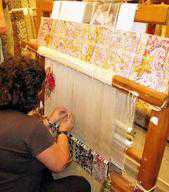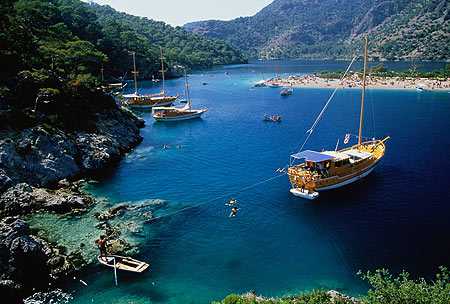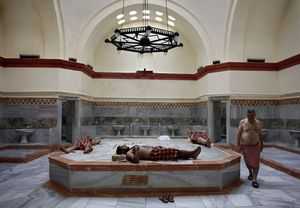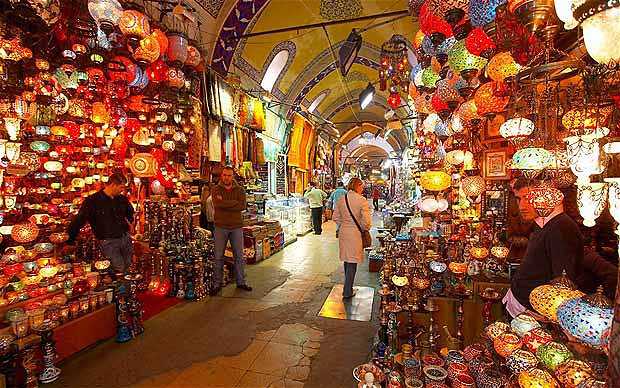By Beverly Burmeier
SPECIAL TO THE AMERICAN-STATESMAN
 My tastes in decorating run more contemporary than antique, so on a recent trip to the Middle East I was stunned by my urge to buy a Turkish rug. But visiting Istanbul draws you into the culture so even those of us who prefer clean lines and sleek shapes quickly come to appreciate the intricacies of traditional carpet weaving and the intense labor necessary to create these works of art.
My tastes in decorating run more contemporary than antique, so on a recent trip to the Middle East I was stunned by my urge to buy a Turkish rug. But visiting Istanbul draws you into the culture so even those of us who prefer clean lines and sleek shapes quickly come to appreciate the intricacies of traditional carpet weaving and the intense labor necessary to create these works of art.
That’s what a Turkish rug really is — a work of art crafted by master weavers who have practiced for decades to perfect complex techniques. The look and feel of a genuine handmade Turkish carpet can’t be duplicated by a machine, as we saw during a weaving demonstration that explained the different fibers used in the art.
Fast-forward to two modern-style aficionados (my husband, Larry, and me) surrounded by all manner of rugs in an Istanbul rug shop, falling under the spell of the suave Turkish carpet salesman.
The rugs are beautiful, and the atmosphere is electric. My decorating style is doing flip-flops.
First comes the invitation to sit down and sip a cup of tea or glass of wine. If you’re browsing in a dedicated carpet store or the Grand Bazaar (as opposed to a street-side shop), accepting the invitation indicates you’re more than a casual window-shopper.
That brings us to Lesson 1: Rug buying takes time.
A little chit-chat later, the salesman starts spreading around rugs in multiple colors and patterns and invites us to slip off our shoes and walk on the samples. Larry is busy with his second glass of wine, so I take the bait and spread my toes on the soft fibers. Later I realize that was my first “gotcha” moment. I’m quickly falling in love with the workmanship of these beautiful pieces.
Lesson 2: Smooth-talking salesmen will win you over in no time.
Still thinking I’m just enjoying the display of rugs unfurled at my feet by a cadre of rug movers, I admire the patterns and make a mental note of appealing colors and designs. I listen politely as our rug expert explains the craftsmanship behind each carpet.
Lesson 3: If you’re buying, learn what you’re paying for.
Knowing that a 4-by-6-foot cotton-on-cotton rug generally takes two months of labor to complete gives you a better sense of a carpet’s value. A sample rug with a large, broad design was priced at $450. Intricate details in the design of a rug could easily bring the price to $950. A double-knotted wool-on-cotton carpet of the same size typically runs $2,500 because it is more labor-intensive. An heirloom-quality piece can require three weavers eight months of work to complete. My brain goes into spasms adding up dollars.
We also learn that fibers matter. The finest pure silk rugs are “to love, enjoy, and pass on to the next generation,” says our carpet mentor. Translation: That’s way out of our price range. Since a vibrantly colored room-size rug with the characteristic silk shimmer can take three skilled weavers two and a half years of detail-oriented work to complete, I decide to let the kids buy their own heirlooms.
With prices escalating, we jump right in and give the carpet guys a figure we’re willing to pay, knowing full well it isn’t enough for what we want.
Lesson 4: Buying a rug in Turkey requires negotiating, so it’s best to start low.
A Turkish carpet is not a simple souvenir. If you want to get a good deal, do a little homework. (Impromptu purchases are not recommended, despite my experience.) Examine the back side of any carpet you’re considering to check the tightness of the weave and whether it has been repaired. A high-quality, tightly woven rug can last for generations and is a prized inheritance, hence the name “family rug.”
Be aware that what is claimed to be an antique may not really be. Just as a pair of new jeans may be torn to look old, unscrupulous dealers are known to pass off carpets that have been distressed to look ancient — thus bringing in more money.
Larry and I follow the rug expert and handlers into a private room for final selection. They’ve been observing my expressions and have a good idea of what to present. There are more questions: What size rug will fit in my home; what colors and designs do I like. One by one they fetch new pieces and spread them on the floor for my perusal.
This one’s too big? We have another size. You like navy and burgundy? Blue dyes are more expensive. Madam, here’s the perfect rug for you.
And they are right. We shake hands over a wool-on-cotton runner for the entry of our home. Turns out it’s a perfect fit, and the colors blend beautifully. I haven’t compromised my style, just expanded it.
Helping you find the perfect rug
You’ll find carpets of every size, design, color scheme and quality for sale in small stalls, street-side shops, and elegant showrooms throughout Turkey. Deal with a trusted merchant who offers a certificate of authenticity and guarantee. Your carpet will most likely be shipped to your home (make sure costs are included in the price), and you want to receive the same carpet you bought.
Oriental Rugs: “Turkish (Vol. 4)” is a good resource book
Turkish Forum Store
via American Statesman






